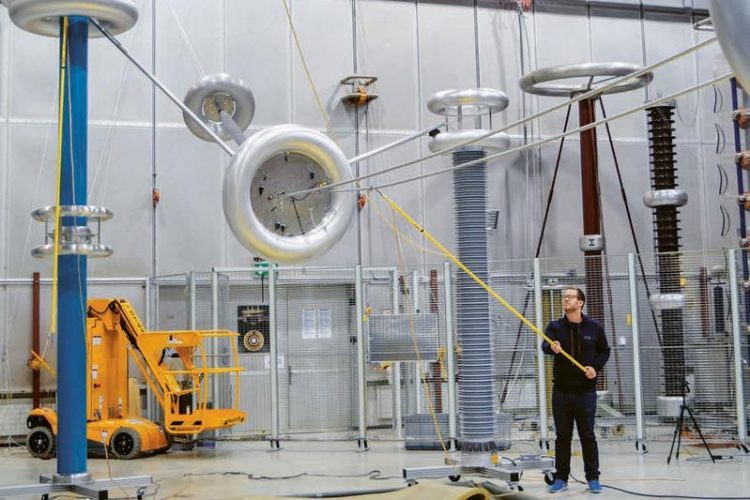Hybrid overhead lines: More power, not more power lines

Under the rain machine in the high-voltage lab of ETH Zurich, researchers are able to precisely test the behaviour of hybrid power lines. ©Jurij Pachin, ETH High Voltage Lab
Unlike conventional power lines, hybrid overhead lines combine alternating current (AC) and direct current (DC) systems on the same tower instead of two AC systems. This increases transmission capacity even though the height and width of the lines remain identical, and it avoids new construction and encroachment on the landscape. However, interference caused by the weather, contamination of the AC and DC conductor cables or the distance between cables can lead to bothersome noise and electric fields.
As part of the National Research Programme “Energy Turnaround” (NRP 70), a team of researchers at ETH Zurich investigated the optimal design of this hybrid system. “Hybrid overhead lines have two major advantages: their capacity is over 50 per cent higher and they are more likely to be accepted because you can upgrade existing high-voltage lines rather than build new ones.
To minimise interference effects associated with the higher transmission capacity, such as corona humming and electric fields, we determined the best voltage and tower geometry using test lines under various real-world conditions both in the laboratory and in the field,” says project lead Christian Franck, Professor at the ETH Zurich's Institute for Power Systems and High Voltage Technology.
Many advantages, but acceptance is not a given
While the new technology was being developed, the opportunities and means for achieving the necessary social acceptance were also being investigated. “Even though higher capacity without encroaching on the landscape favours the new hybrid technology, and we'll be able to significantly reduce the negative effects, we knew from the outset that hybrid overhead lines weren't going to happen without the consent of the people directly affected by them,” says Franck. Which explains the collaboration with the Institute for Political Science at the University of Bern.
Isabelle Stadelmann-Steffen, Professor at the University of Bern, is investigating the social acceptance of renewable energies as part of the National Research Programme “Managing Energy Consumption” (NRP 71). The survey of roughly 1300 individuals about their attitudes towards hybrid overhead lines revealed three key findings: “First, information about any new technology must be provided proactively.
Ideally, the community needs to be involved as early as possible to get across the importance of the project while providing the opportunity to include opinions and concerns in the decision-making process. Second, alternatives must be discussed, because the support for a new technology is always weighed against the alternatives. And third, the extent to which you can reduce the negative effects of a technology will naturally increase acceptance.”
Better technology through interdisciplinary collaboration
The close collaboration between the researchers at ETH Zurich and the University of Bern, as well as the Swiss transmission system operator Swissgrid and distribution network and hydropower plant operators, enabled real technological advances.
The ETH Zurich's engineers focused primarily on maximising transmission capacity without compromising the limit values for electromagnetic fields and noise, while findings from the research on social acceptance helped to determine an optimal balance between high capacity and the lowest possible “perceptibility”.
Contact
Prof Dr Isabelle Stadelmann-Steffen
University of Bern
Institute of Political Science
Fabrikstrasse 8
3012 Bern
Tel.: +41 31 631 83 55
E-mail: isabelle.stadelmann@ipw.unibe.ch
Prof Dr Christian M. Franck
Institute for Power Systems and High Voltage Technology
ETH Zurich
Physikstrasse 3
8092 Zurich
Tel.: +41 44 632 47 62
E-mail: cfranck@ethz.ch
The National Research Programmes “Energy Turnaround” and “Managing Energy Consumption”
The Swiss National Science Foundation's National Research Programmes “Energy Turnaround” (NRP 70) and “Managing Energy Consumption” (NRP 71) are investigating the scientific and technological as well as socioeconomic aspects of the successful implementation of the Energy Turnaround. By the end of 2018, more than 300 researchers in over 100 research projects will be working on ways to substantially reduce energy consumption, develop new technologies and determine the social prerequisites for their implementation in the next 10 to 30 years.
NRP 70 and NRP 71 are running concurrently. Owing to their many overlapping areas of interest, the two programmes are closely coordinated.
Further information on the individual research projects and the organisation of the National Research Programmes is available at www.nrp70.ch and www.nrp71.ch
https://www.youtube.com/watch?v=BeL6VTwCJy0&index=1&list=PLCVDS7lWRkvIq7…
https://youtu.be/C9A22vSVE6U
http://www.snf.ch/SiteCollectionDocuments/medienmitteilungen/180604_MM_Hybride_F… 'Addendum on the acceptance study'
http://www.nfp70.ch/en/projects/electricity-supply/hybrid-overhead-power-lines
http://www.nfp71.ch/en/projects/module-4-acceptance/acceptance-of-renewable-ener…
Media Contact
All latest news from the category: Power and Electrical Engineering
This topic covers issues related to energy generation, conversion, transportation and consumption and how the industry is addressing the challenge of energy efficiency in general.
innovations-report provides in-depth and informative reports and articles on subjects ranging from wind energy, fuel cell technology, solar energy, geothermal energy, petroleum, gas, nuclear engineering, alternative energy and energy efficiency to fusion, hydrogen and superconductor technologies.
Newest articles

A ‘language’ for ML models to predict nanopore properties
A large number of 2D materials like graphene can have nanopores – small holes formed by missing atoms through which foreign substances can pass. The properties of these nanopores dictate many…

Clinically validated, wearable ultrasound patch
… for continuous blood pressure monitoring. A team of researchers at the University of California San Diego has developed a new and improved wearable ultrasound patch for continuous and noninvasive…

A new puzzle piece for string theory research
Dr. Ksenia Fedosova from the Cluster of Excellence Mathematics Münster, along with an international research team, has proven a conjecture in string theory that physicists had proposed regarding certain equations….



